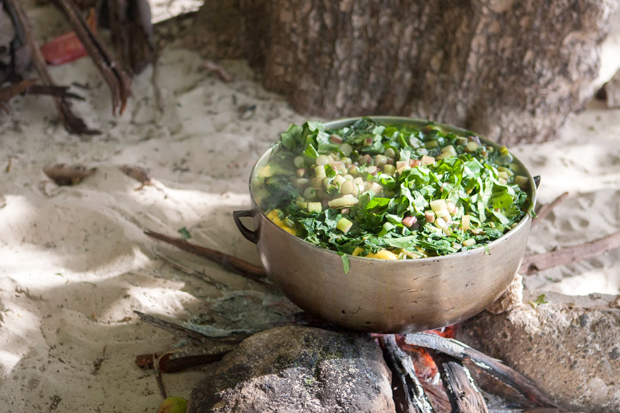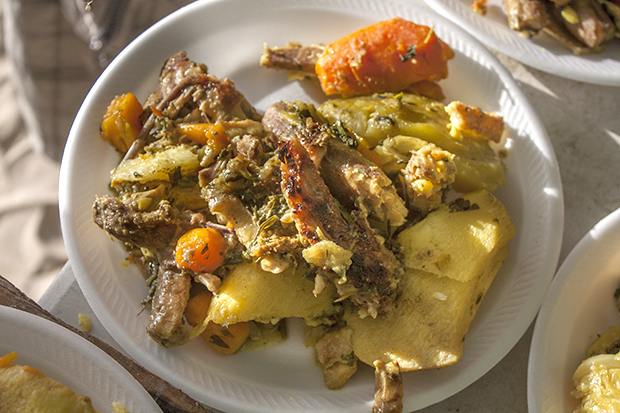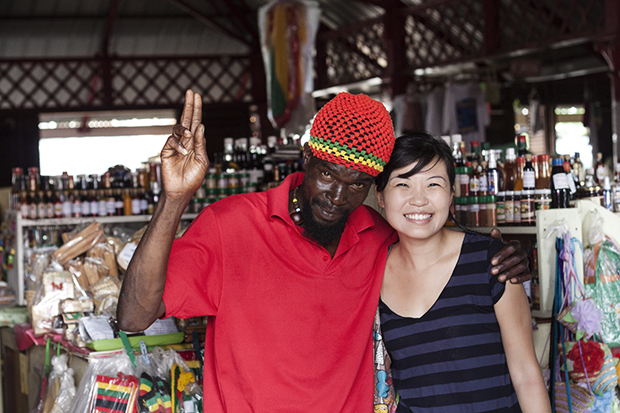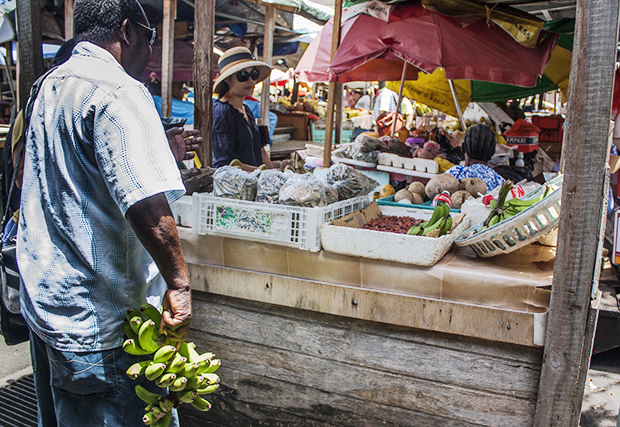
There’s nothing glamorous or refined about oil down; it’s a humble dish from a humble country. On this small Caribbean island, where hard-working locals have to deal with limited freshwater, seasonal rainfall, and natural disasters, and where the majority of its food is imported from the US and neighboring islands, Grenadians are proud to claim oil down as their own.
The majority of the locals here are of African origin, the descendants of slaves brought over to work on European-owned plantations. Although Grenada became an independent country in 1974, it has retained an identity deeply rooted in European culture. Many street names, neighborhoods, and bays (Mont Tout, Carenage, Morne Rouge) have French influence, while the currency (Eastern Caribbean dollar) pays tribute to the queen of England, and British English is taught in schools. As a result, the local customs, language, food, religion, and architecture are a rich blend of each of these different influences, each lending a unique flavor to the culture of Grenada.

Although many things in Grenada have been influenced by the Europeans over the years, oil down remains something purely Grenadian. No imported spices or seasonings, no choice cuts of meat here. This one-pot meal is made up of local veggies, “provisions” (the local term for starchy roots, tubers, and bananas that fill you up), salted meat, and aromatic seasoning —  all easily accessible, affordable ingredients in Grenada. All these components are combined in a large pot and cooked down in coconut milk over an open fire. In fact, the name of the dish comes from the coconut oils released from the coconut milk as it simmers and is absorbed by the other ingredients.

Oil down is comfort food at its Caribbean best. And of course, like any comfort food, mom or grandma always makes the best version! I was fortunate to have gotten to know someone local to the island whom I could ask to teach me how to make this dish. During my time in Grenada, I frequented the public market in St. George’s often enough that I became friends with a lot of my favorite vendors there. In particular, I ordered so much handmade jewelry from Billy that we were soon on a first-name basis. I’d stand there and watch him make jewelry some days, we’d haggle good-naturedly over different pieces, and when my friends and I had heavy bags filled with mangoes and bananas from the market, we’d leave them with Billy as we finished our shopping in town. We even spent an afternoon with Billy and his friends trekking through the rainforest, as he showed us where he collects his seeds for jewelry-making. So, it didn’t take too much convincing when I asked Billy to show me how to make oil down.

Our day began at the market where Billy and his friends showed us the ingredients we’d need for making this dish. After picking up all these items, we lugged everything (including a huge pot) to the beach to begin our cookout. When your meal needs time to simmer, the beach is the best place to wait!
While this dish is relatively easy to make (throw everything in a pot and let it simmer!), it usually turns into an all-day event. Because it tastes best cooked over an open flame, families will often make oil down at the beach, at sporting events, at hashes (organized, weekly hikes around the island), or any place where you need to feed a large group of people. And if you know Grenadians, they love to lime (a Grenadian term for something like “chilling”). In fact, “oil down” actually refers to both the dish as well as the act or event of making it. An oil down typically involves families spending the whole day at the beach. Everybody pitches in to help, and as the food cooks, children will jump in the water, young boys will play soccer, moms will watch the babies, and the men will lounge around, liming. You can’t truly experience this dish without taking part in the making and sharing of it!
I hope that by recording this recipe, I can pay tribute in some small way to Billy, to the friends I met on the island, and to the two years that my husband and I shared together so far away from home. Yes, Grenada is not in the media much (aside from the invasion by the US in the 80s), nor is it at the top of anybody’s must-see travel destinations (heck, I couldn’t even convince my sister to visit me while I was there!), but it has a simplicity and sincerity that I’ve grown to love and miss after I left just two months ago. The island’s only recently become more tourist-friendly, but many locals still don’t really know how to interact or deal with foreigners (they’ll often resort to either catcalling or brusqueness). But if you have a thick skin, an open mind, and are sure to mind your “morning,” “afternoon,” or “good nights,” you’ll find some of the friendliest, kindest people you’ll ever meet.
Oil down, in all its simple and unassuming nature, has really come to represent Grenada for me — something I can bring back home and remember the island by. At first glance, the dish doesn’t look like it has much to offer, and you may not quite know what to make of it. It’s not exactly a stew, nor a curry. And it’s lost a lot of its vibrant colors after simmering for so many hours. But if you’ll take the time to dig a little deeper, open up yourself, and give it a chance, you’ll find hidden beneath modest ingredients, the very heart and soul of a country and its people.


















Connect with us